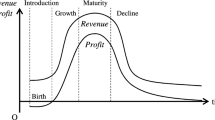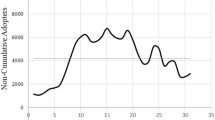Abstract
In this paper, we propose a new model of adoption and repurchase due to upgrades driven by the utility of technology products that keep improving. The model is able to predict product life cycle patterns that could not be explained previously. Such patterns were used to challenge diffusion theory validity. Mathematically, the model is described as a nonlinear discrete system that depends on a small set of parameters. We investigate the dynamic properties of the nonlinear system using numerical stability analysis. We find domains in the parameters space in which the equilibrium point and the periodical orbits are stable. The domains correspond to population heterogeneity, tendency to upgrade, and the influence of industry response on market dynamics. We also implement our model to fit actual data of two real-world product life cycles with many irregularities and benchmark the results of our model vs. well-known models.






Similar content being viewed by others
Notes
The examples are available from the authors upon request.
Note that, unlike Chandrasekaran and Tellis (2011), we model the entire product life cycle and are not limited to forecasting only the edges of the “irregular” periods.
Adoption is measured as a portion of the maximal potential market (at maximum utility).
We calculated sales for up to 100 periods while the adoption peak time was at 20.
The threshold is not precisely the peak, which match utility increase of \( 0.5\times \left( {1-{{{\widetilde{u}}}_0}} \right) \), but a short time, observed numerically, after the peak.
We calculated the sales for 100 periods.
References
Bass, F. M. (1969). A new product growth model for consumer durables. Management Science, 15, 215–227.
Bass, P. I., & Bass, F. M. (2001). Diffusion of technology generations: a model of adoption and repeat sales. INFORMS Marketing Science Conference presentation. Available at www.basseconomics.com.
Bayus, B. L. (1988). Accelerating the durable replacement cycle with marketing mix variables. The Journal of Product Innovation Management, 5(3), 216–226.
Buzzell, R. (1966). Competitive behavior and product life cycles. In J. Wright & J. Goldstucker (Eds.), New ideas for successful marketing (pp. 46–68). Chicago: American Marketing Association.
Carrasco, J. M. F., Ortega, E. M., & Cordeiro, G. M. (2008). A generalized modified Weibull distribution for lifetime modeling. Computational Statistics and Data Analysis, 53(2), 450–462.
Chandrasekaran, D., & Tellis, G. J. (2007). A critical review of marketing research on diffusion of new products. In N. K. Malhotra (Ed.), Review of marketing research (Vol. 3, pp. 39–80). New York: M. E. Sharpe.
Chandrasekaran, D., & Tellis, G. J. (2011). Getting a grip on the saddle: chasms or cycles? The Journal of Marketing, 75(4), 21–34.
Cho, S. J. (2008). The effectiveness of parametric approximation: a case of mainframe computer investment. Journal of Economic Research, 13, 125–148.
Collet, P., & Eckerman, J. P. (1980). Iterated maps on the interval as dynamical systems. Boston, MA: Birkhauser.
Cox, W. J. (1967). Product life cycles as marketing models. Journal of Business, 40, 375–384.
Fader, P. S., & Hardie, B. G. S. (2003). Can we infer 'Trial and Repeat' numbers from aggregate sales data? Available at http://brucehardie.com/papers/fader_hardie_aggtr0703.pdf
Fernandez, V. (1999). Forecasting home appliances sales: incorporating adoption and replacement. Journal of International Consumer Marketing, 12(2), 39–61.
Goldenberg, J., Libai, B., & Muller, E. (2002). Riding the saddle: how cross-market communications can create a major slump in sales. The Journal of Marketing, 66, 1–16.
Gordon, B. R. (2006). Replacement cycles and innovation in the PC processor industry: a dynamic structural approach. Carnegie Mellon University Job Market Paper, June 2006.
Javed, M., & Saleem, M. (2012). A Bayesian analysis of the Rayleigh life time model. World Applied Sciences Journal, 16(2), 220–226.
Kamakura, W. A., & Balasubramanian, S. K. (1987). Long-term forecasting with innovation diffusion models: the impact of replacement purchases. Journal of Forecasting, 6(1), 1–19.
Katz, M., & Shapiro, C. (1985). Network externalities, competition, and compatibility. The American Economic Review, 75, 424–440.
Katz, M., & Shapiro, C. (1986). Technology adoption in the presence of network externalities. Journal of Political Economy, 94, 822–841.
Lalitha, S., & Mishra, A. (1996). Modified maximum likelihood estimation for Rayleigh distribution. Communications in Statistics: Theory and Methods, 25, 389–401.
Lin, C., & Chen, C. (2008). CMAC-based supervisory control for nonlinear chaotic systems. Chaos Soliton and Fractals, 35, 40–58.
Loch, C. H., & Huberman, B. A. (1999). A punctuated-equilibrium model of technology diffusion. Management Science, 45(2), 160–177.
Mahajan, V., & Muller, E. (1996). Timing, diffusion and substitution of successive generations of technological innovations: the IBM mainframe case. Technological Forecasting and Social Change, 51, 109–132.
Mahajan, V., Sharma S., & Wind Y. (1983). An approach to repeat-purchase diffusion analysis. In: Proceedings of the 1983 AMA Conference, pp. 442–446.
Mahajan, V., Muller, E., & Bass, F. M. (1993). New product diffusion models. In J. Eliashberg & G. L. Lilien (Eds.), Handbooks in operations research and management science (pp. 349–408). New York: Elsevier.
Maier, F. H. (1996). Substitution among successive product generations - An almost neglected problem in innovation diffusion research. Paper presented at the 1996 International System Dynamics Conference, Cambridge, Massachusetts. Mannheim, Germany: University.
May, R. M. (1976). Simple mathematical models with very complicated dynamics. Nature, 261(5560), 459–467.
Morrison, D. G. (1969). On the interpretation of discriminant analysis. Journal of Marketing Research, 6, 156–163.
Norton, J. A., & Bass, F. M. (1987). A diffusion theory model of adoption and substitution for successive generations of high-technology products. Management Science, 33, 1069–1086.
Olson, J., & Choi, S. (1985). A product diffusion model incorporating repeat purchases. Technological Forecasting and Social Change, 27, 385–397.
Orbach, Y., & Fruchter, G. E. (2010). A utility-based diffusion model applied to the digital camera case. Review of Marketing Science, 8(1), 1–26.
Rink, D., & Swan, J. (1979). Product life cycle research: a literature review. Journal of Business Research, 40, 219–243.
Russell, T. (1980). Comments on ‘The relationship between diffusion rates, experience curves and demand elasticities for consumer durable technological innovations’. Journal of Business, 53(3), 69–73.
Schmidt, G. M., & Druehl, C. T. (2005). Changes in product attributes and cost as drivers of new product diffusion and substitution. Production and Operations Management, 14(3), 272–285.
Srivastava, R. K., Mahajan, V., Ramaswami, S. N., & Cherian, J. (1985). A multi-attribute diffusion model for forecasting the adoption of investment alternatives for consumers. Technological Forecasting and Social Change, 28, 325–333.
Steffens, P. R. (2002). The product life cycle concept: Buried or resurrected by the diffusion literature? Academy of Management Conference, Technology and Innovation Management Division, Denver, August 2002. Available at http://eprints.qut.edu.au/archive/00006522/02/6522.pdf
Strogatz, S. H. (1994). Nonlinear dynamics and chaos: with applications to physics, biology, chemistry, and engineering. Reading: Addison-Wesley
Tellis, G., & Crawford, M. (1981). An evolutionary approach to product growth theory. The Journal of Marketing, 45(Fall), 125–132.
Thun, J. H., Grobler, A., & Milling, P. M. (2000). The diffusion of goods considering network externalties. In: Proceeding of the 18th International Conference of the System Dynamics Society, Bergen, Norway.
Van den Bulte, C., & Joshi, Y. V. (2007). New product diffusion with influential and imitators. Marketing Science, 26(3), 1–23.
Weerahandi, S., & Dalal, S. R. (1992). A choice based approach to the diffusion of a service: forecasting fax penetration by market segments. Marketing Science, 11(1), 39–53.
Acknowledgments
The authors thank the editor and anonymous reviewers for the very helpful and constructive comments that lead to a significantly improved manuscript. In addition, the authors thank Oded Gottlieb for his very helpful advice regarding the numerical analysis of cycles and chaos in nonlinear dynamic systems.
Author information
Authors and Affiliations
Corresponding author
Rights and permissions
About this article
Cite this article
Orbach, Y., Fruchter, G.E. Predicting product life cycle patterns. Mark Lett 25, 37–52 (2014). https://doi.org/10.1007/s11002-013-9239-0
Published:
Issue Date:
DOI: https://doi.org/10.1007/s11002-013-9239-0




